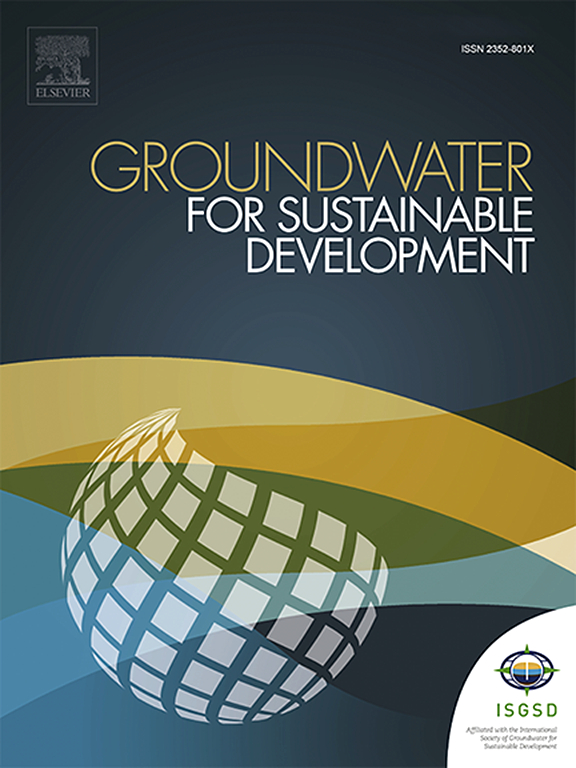Understanding groundwater behaviour in urban environments: thermal and piezometric analysis in the Turin city area (NW Italy)
IF 4.9
Q2 ENGINEERING, ENVIRONMENTAL
引用次数: 0
Abstract
This study investigated the thermal and piezometric characteristics of the shallow aquifer in the Turin metropolitan area (north-western Italy), focusing on the dynamics and management of groundwater (GW) resources. The analysis includes data collected by the regional monitoring network in Turin and surrounding areas between 2010 and 2022. During this period, an average decrease in the water table of approximately 1 m and an increase in the GW temperature (GWT) of approximately 0.5 °C were observed. The GWT and water table data were also measured during three field campaigns in 2022 using a network of 31 monitoring points in the city of Turin. The data show that GW flows from west to east towards the Po River, with values ranging from 240 m a.s.l. to approximately 210 m a.s.l. Moreover, a decrease in the water table depth throughout the monitored year was observed. The GWT increases from west to east in the flow direction, with values ranging from 13 °C to 17.5 °C. The temperature profiles and the spatial distribution show typical seasonal dynamics following air temperature fluctuations. Seasonal variations are diminished by the saturated and unsaturated zones, with the GWT stabilising below 4–6 m from the water table and 20 m below ground level. This comprehensive analysis highlights the impact of anthropogenic activities and climate change on GWT and emphasises the need for improved monitoring and management strategies to protect GW resources, especially in urban areas.

了解地下水在城市环境中的行为:都灵城区(意大利西北部)的热学和测压分析
本研究调查了都灵大都市区(意大利西北部)浅层含水层的热量和压力特征,重点研究了地下水(GW)资源的动态和管理。该分析包括2010年至2022年间都灵及周边地区区域监测网络收集的数据。在此期间,地下水位平均下降约1 m,全球气温(GWT)上升约0.5°C。在2022年的三次实地活动中,还利用都灵市31个监测点的网络测量了GWT和地下水位数据。数据表明,GW从西向东流向波河,其值在240 ~ 210 m a.s.l之间,并且在整个监测年份中,地下水位呈下降趋势。在气流方向上,GWT从西向东增加,值在13℃~ 17.5℃之间。气温廓线和空间分布表现出典型的随气温波动而变化的季节特征。饱和带和不饱和带减少了季节变化,GWT稳定在距地下水位4-6 m以下和距地面20 m以下。这一综合分析强调了人为活动和气候变化对GWT的影响,并强调需要改进监测和管理战略,以保护GWT资源,特别是在城市地区。
本文章由计算机程序翻译,如有差异,请以英文原文为准。
求助全文
约1分钟内获得全文
求助全文
来源期刊

Groundwater for Sustainable Development
Social Sciences-Geography, Planning and Development
CiteScore
11.50
自引率
10.20%
发文量
152
期刊介绍:
Groundwater for Sustainable Development is directed to different stakeholders and professionals, including government and non-governmental organizations, international funding agencies, universities, public water institutions, public health and other public/private sector professionals, and other relevant institutions. It is aimed at professionals, academics and students in the fields of disciplines such as: groundwater and its connection to surface hydrology and environment, soil sciences, engineering, ecology, microbiology, atmospheric sciences, analytical chemistry, hydro-engineering, water technology, environmental ethics, economics, public health, policy, as well as social sciences, legal disciplines, or any other area connected with water issues. The objectives of this journal are to facilitate: • The improvement of effective and sustainable management of water resources across the globe. • The improvement of human access to groundwater resources in adequate quantity and good quality. • The meeting of the increasing demand for drinking and irrigation water needed for food security to contribute to a social and economically sound human development. • The creation of a global inter- and multidisciplinary platform and forum to improve our understanding of groundwater resources and to advocate their effective and sustainable management and protection against contamination. • Interdisciplinary information exchange and to stimulate scientific research in the fields of groundwater related sciences and social and health sciences required to achieve the United Nations Millennium Development Goals for sustainable development.
 求助内容:
求助内容: 应助结果提醒方式:
应助结果提醒方式:


